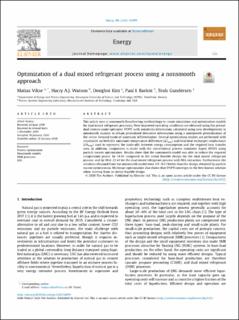| dc.contributor.author | Vikse, Matias | |
| dc.contributor.author | Watson, Harry | |
| dc.contributor.author | Kim, Donghoi | |
| dc.contributor.author | Barton, Paul | |
| dc.contributor.author | Gundersen, Truls | |
| dc.date.accessioned | 2021-03-04T12:44:24Z | |
| dc.date.available | 2021-03-04T12:44:24Z | |
| dc.date.created | 2020-10-15T15:33:38Z | |
| dc.date.issued | 2020 | |
| dc.identifier.citation | Energy. 2020, 196, 1-12. | en_US |
| dc.identifier.issn | 0360-5442 | |
| dc.identifier.uri | https://hdl.handle.net/11250/2731655 | |
| dc.description.abstract | This article uses a nonsmooth flowsheeting methodology to create simulation and optimization models for dual mixed refrigerant processes. New improved operating conditions are obtained using the primal-dual interior-point optimizer IPOPT, with sensitivity information calculated using new developments in nonsmooth analysis to obtain generalized derivative information using a nonsmooth generalization of the vector forward mode of automatic differentiation. Several optimization studies are performed with constraints on both the minimum temperature difference () and total heat exchanger conductance () used to represent the trade-offs between energy consumption and the required heat transfer area. In addition, comparison is made with the conventional process simulator Aspen HYSYS using particle swarm optimization. Results show that the nonsmooth model was able to reduce the required compression power by 14.4% compared to the initial feasible design for the dual mixed refrigerant process, and by 20.4–21.6% for the dual mixed refrigerant process with NGL extraction. Furthermore, the solutions obtained from the nonsmooth model were 1.9–8.1% better than the design obtained by particle swarm optimization. Multistart optimization also shows that IPOPT converges to the best known solution when starting from an initial feasible design. | en_US |
| dc.language.iso | eng | en_US |
| dc.publisher | Elsevier | en_US |
| dc.rights | Navngivelse 4.0 Internasjonal | * |
| dc.rights.uri | http://creativecommons.org/licenses/by/4.0/deed.no | * |
| dc.title | Optimization of a dual mixed refrigerant process using a nonsmooth approach | en_US |
| dc.type | Peer reviewed | en_US |
| dc.type | Journal article | en_US |
| dc.description.version | publishedVersion | en_US |
| dc.source.pagenumber | 1-12 | en_US |
| dc.source.volume | 196 | en_US |
| dc.source.journal | Energy | en_US |
| dc.identifier.doi | 10.1016/j.energy.2020.116999 | |
| dc.identifier.cristin | 1839893 | |
| dc.description.localcode | ©2020 The Authors. Published by Elsevier Ltd. This is an open access article under the CC BY license(http://creativecommons.org/licenses/by/4.0/) | en_US |
| cristin.ispublished | true | |
| cristin.fulltext | postprint | |
| cristin.qualitycode | 2 | |

